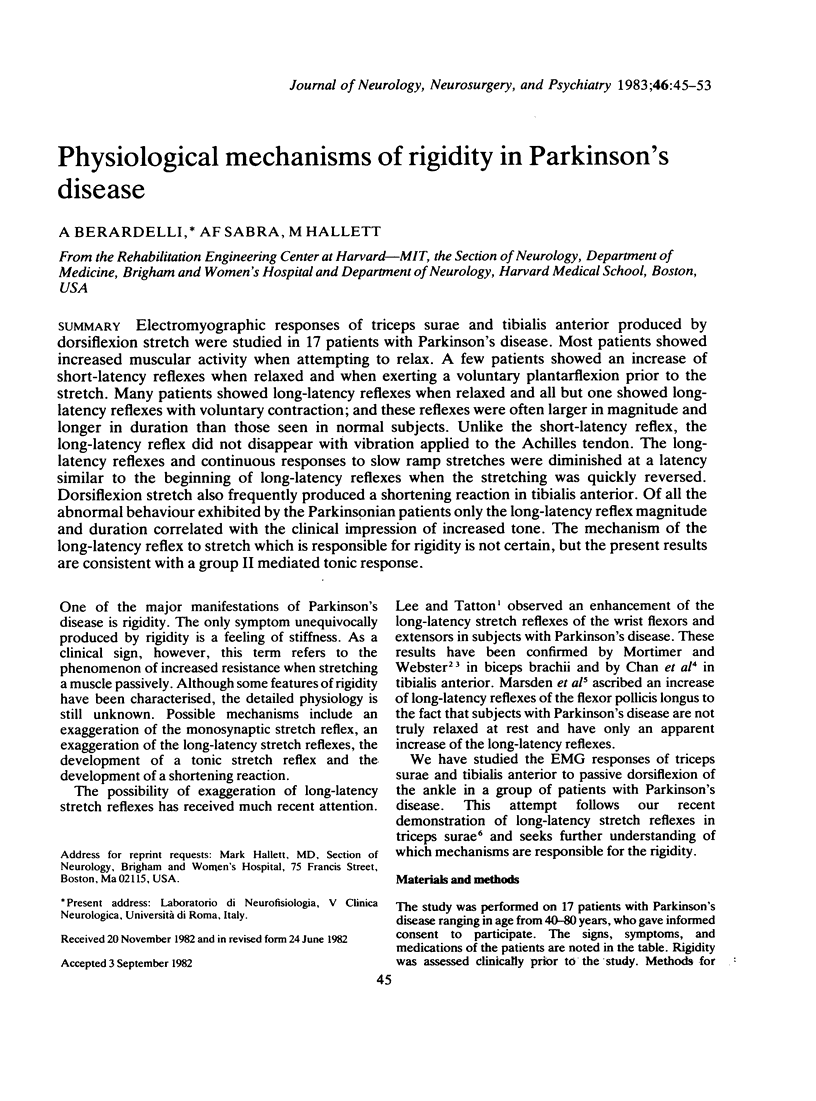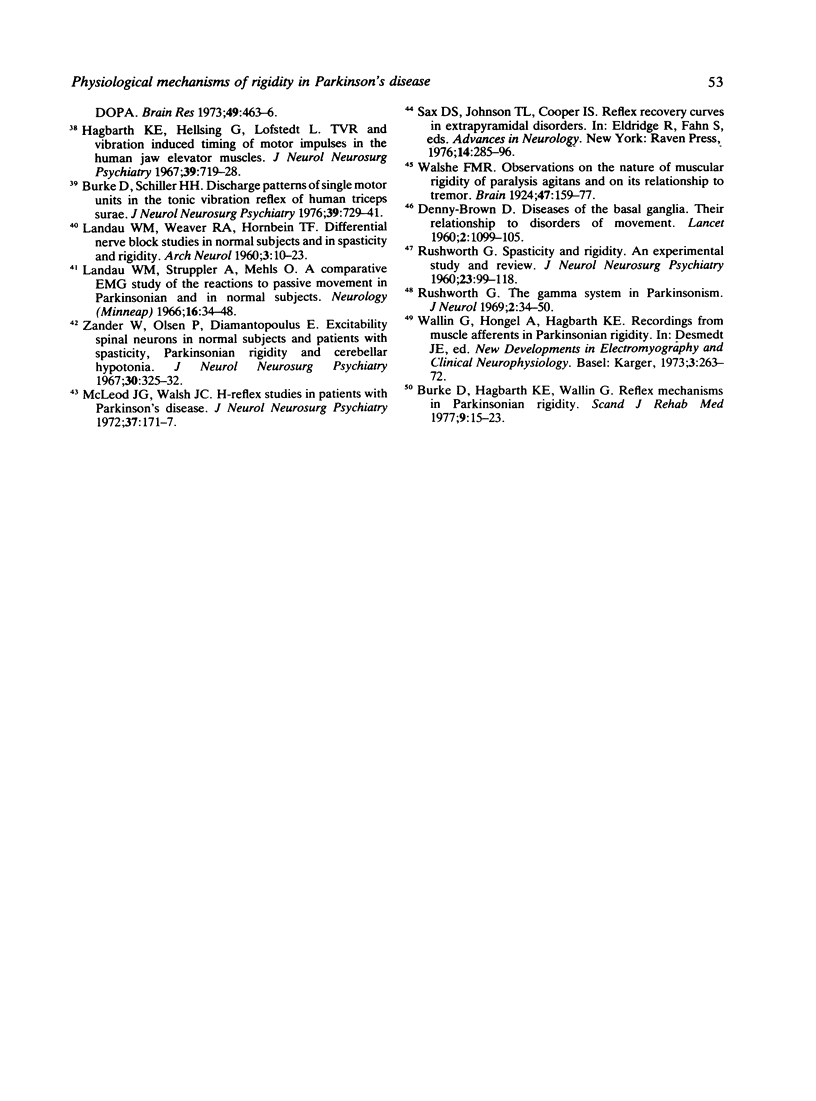Abstract
Electromyographic responses of triceps surae and tibialis anterior produced by dorsiflexion stretch were studied in 17 patients with Parkinson's disease. Most patients showed increased muscular activity when attempting to relax. A few patients showed an increase of short-latency reflexes when relaxed and when exerting a voluntary plantarflexion prior to the stretch. Many patients showed long-latency reflexes when relaxed and all but one showed long-latency reflexes with voluntary contraction; and these reflexes were often larger in magnitude and longer in duration than those seen in normal subjects. Unlike the short-latency reflex, the long-latency reflex did not disappear with vibration applied to the Achilles tendon. The long-latency reflexes and continuous responses to slow ramp stretches were diminished at a latency similar to the beginning of long-latency reflexes when the stretching was quickly reversed. Dorsiflexion stretch also frequently produced a shortening reaction in tibialis anterior. Of all the abnormal behavior exhibited by the Parkinsonian patients only the long-latency reflex magnitude and duration correlated with the clinical impression of increased tone. The mechanism of the long-latency reflex to stretch which is responsible for rigidity is not certain, but the present results are consistent with a group II mediated tonic response.
Full text
PDF








Selected References
These references are in PubMed. This may not be the complete list of references from this article.
- Andrews C. J., Burke D., Lance J. W. The response to muscle stretch and shortening in Parkinsonian rigidity. Brain. 1972;95(4):795–812. doi: 10.1093/brain/95.4.795. [DOI] [PubMed] [Google Scholar]
- Berardelli A., Hallett M., Kaufman C., Fine E., Berenberg W., Simon S. R. Stretch reflexes of triceps surae in normal man. J Neurol Neurosurg Psychiatry. 1982 Jun;45(6):513–525. doi: 10.1136/jnnp.45.6.513. [DOI] [PMC free article] [PubMed] [Google Scholar]
- Brown M. C., Engberg I., Matthews P. B. The relative sensitivity to vibration of muscle receptors of the cat. J Physiol. 1967 Oct;192(3):773–800. doi: 10.1113/jphysiol.1967.sp008330. [DOI] [PMC free article] [PubMed] [Google Scholar]
- Burke D., Hagbarth K. E., Löfstedt L., Wallin B. G. The responses of human muscle spindle endings to vibration during isometric contraction. J Physiol. 1976 Oct;261(3):695–711. doi: 10.1113/jphysiol.1976.sp011581. [DOI] [PMC free article] [PubMed] [Google Scholar]
- Burke D., Hagbarth K. E., Löfstedt L., Wallin B. G. The responses of human muscle spindle endings to vibration of non-contracting muscles. J Physiol. 1976 Oct;261(3):673–693. doi: 10.1113/jphysiol.1976.sp011580. [DOI] [PMC free article] [PubMed] [Google Scholar]
- Burke D., Hagbarth K. E., Wallin B. G. Reflex mechanisms in Parkinsonian rigidity. Scand J Rehabil Med. 1977;9(1):15–23. [PubMed] [Google Scholar]
- Burke D., Schiller H. H. Discharge pattern of single motor units in the tonic vibration reflex of human triceps surae. J Neurol Neurosurg Psychiatry. 1976 Aug;39(8):729–741. doi: 10.1136/jnnp.39.8.729. [DOI] [PMC free article] [PubMed] [Google Scholar]
- Chan C. W., Kearney R. E., Jones G. M. Tibialis anterior response to sudden ankle displacements in normal and Parkinsonian subjects. Brain Res. 1979 Sep 14;173(2):303–314. doi: 10.1016/0006-8993(79)90630-9. [DOI] [PubMed] [Google Scholar]
- Clark F. J., Matthews P. B., Muir R. B. Response of soleus Ia afferents to vibration in the presence of the tonic vibration reflex in the decerebrate cat. J Physiol. 1981 Feb;311:97–112. doi: 10.1113/jphysiol.1981.sp013575. [DOI] [PMC free article] [PubMed] [Google Scholar]
- DENNY-BROWN D. Diseases of the basal ganglia. Their relation to disorders of movement. Lancet. 1960 Nov 19;2(7160):1099–1105. doi: 10.1016/s0140-6736(60)92186-3. [DOI] [PubMed] [Google Scholar]
- Evarts E. V., Tanji J. Reflex and intended responses in motor cortex pyramidal tract neurons of monkey. J Neurophysiol. 1976 Sep;39(5):1069–1080. doi: 10.1152/jn.1976.39.5.1069. [DOI] [PubMed] [Google Scholar]
- Ghez C., Shinoda Y. Spinal mechanisms of the functional stretch reflex. Exp Brain Res. 1978 May 12;32(1):55–68. doi: 10.1007/BF00237390. [DOI] [PubMed] [Google Scholar]
- Goodwin G. M., McGrath G. J., Matthews P. B. The tonic vibration reflex seen in the acute spinal cat after treatment with DOPA. Brain Res. 1973 Jan 30;49(2):463–466. doi: 10.1016/0006-8993(73)90443-5. [DOI] [PubMed] [Google Scholar]
- Hagbarth K. E., Hellsing G., Löfstedt L. TVR and vibration-induced timing of motor impulses in the human jaw elevator muscles. J Neurol Neurosurg Psychiatry. 1976 Aug;39(8):719–728. doi: 10.1136/jnnp.39.8.719. [DOI] [PMC free article] [PubMed] [Google Scholar]
- Hagbarth K. E., Vallbo A. B. Discharge characteristics of human muscle afferents during muscle stretch and contraction. Exp Neurol. 1968 Dec;22(4):674–694. doi: 10.1016/0014-4886(68)90156-8. [DOI] [PubMed] [Google Scholar]
- Jack J. J., Roberts R. C. The role of muscle spindle afferents in stretch and vibration reflexes of the soleus muscle of the decerebrate cat. Brain Res. 1978 May 12;146(2):366–372. doi: 10.1016/0006-8993(78)90981-2. [DOI] [PubMed] [Google Scholar]
- Kirkwood P. A., Sears T. A. Monosynaptic excitation of motoneurones from secondary endings of muscle spindles. Nature. 1974 Nov 15;252(5480):243–244. doi: 10.1038/252243a0. [DOI] [PubMed] [Google Scholar]
- LANDAU W. M., WEAVER R. A., HORNBEIN T. F. Fusimotor nerve function in man. Differential nerve block studies in normal subjects and in spasticity and rigidity. Arch Neurol. 1960 Jul;3:10–23. doi: 10.1001/archneur.1960.00450010010002. [DOI] [PubMed] [Google Scholar]
- Landau W. M., Struppler A., Mehls O. A comparative electromyographic study of the reactions to passive movement in parkinsonism and in normal subjects. Neurology. 1966 Jan;16(1):34–48. doi: 10.1212/wnl.16.1.34. [DOI] [PubMed] [Google Scholar]
- Marsden C. D., Merton P. A., Morton H. B. Servo action in human voluntary movement. Nature. 1972 Jul 21;238(5360):140–143. doi: 10.1038/238140a0. [DOI] [PubMed] [Google Scholar]
- Marsden C. D., Merton P. A., Morton H. B. Servo action in the human thumb. J Physiol. 1976 May;257(1):1–44. doi: 10.1113/jphysiol.1976.sp011354. [DOI] [PMC free article] [PubMed] [Google Scholar]
- Matthews P. B. A reply to criticism of the hypothesis that the group II afferents contribute excitation to the stretch reflex. Acta Physiol Scand. 1970 Jul;79(3):431–433. doi: 10.1111/j.1748-1716.1970.tb04743.x. [DOI] [PubMed] [Google Scholar]
- Matthews P. B. Evidence that the secondary as well as the primary endings of the muscle spindles may be responsible for the tonic stretch reflex of the decerebrate cat. J Physiol. 1969 Oct;204(2):365–393. doi: 10.1113/jphysiol.1969.sp008918. [DOI] [PMC free article] [PubMed] [Google Scholar]
- Matthews P. B. The reflex excitation of the soleus muscle of the decerebrate cat caused by vibbration applied to its tendon. J Physiol. 1966 May;184(2):450–472. doi: 10.1113/jphysiol.1966.sp007926. [DOI] [PMC free article] [PubMed] [Google Scholar]
- McGrath G. J., Matthews P. B. Evidence from the use of vibration during procaine nerve block that the spindle group II fibres contribute excitation to the tonic stretch reflex of the decerebrate cat. J Physiol. 1973 Dec;235(2):371–408. doi: 10.1113/jphysiol.1973.sp010392. [DOI] [PMC free article] [PubMed] [Google Scholar]
- McLellan D. L. Dynamic spindle reflexes and the rigidity of Parkinsonism. J Neurol Neurosurg Psychiatry. 1973 Jun;36(3):342–349. doi: 10.1136/jnnp.36.3.342. [DOI] [PMC free article] [PubMed] [Google Scholar]
- Mortimer J. A., Webster D. D. Evidence for a quantitative association between EMG stretch responses and Parkinsonian rigidity. Brain Res. 1979 Feb 16;162(1):169–173. doi: 10.1016/0006-8993(79)90768-6. [DOI] [PubMed] [Google Scholar]
- Olsen P. Z., Diamantopoulos E. Excitability of spinal motor neurones in normal subjects and patients with spasticity, Parkinsonian rigidity, and cerebellar hypotonia. J Neurol Neurosurg Psychiatry. 1967 Aug;30(4):325–331. doi: 10.1136/jnnp.30.4.325. [DOI] [PMC free article] [PubMed] [Google Scholar]
- Phillips C. G., Powell T. P., Wiesendanger M. Projection from low-threshold muscle afferents of hand and forearm to area 3a of baboon's cortex. J Physiol. 1971 Sep;217(2):419–446. doi: 10.1113/jphysiol.1971.sp009579. [DOI] [PMC free article] [PubMed] [Google Scholar]
- RUSHWORTH G. Spasticity and rigidity: an experimental study and review. J Neurol Neurosurg Psychiatry. 1960 May;23:99–118. doi: 10.1136/jnnp.23.2.99. [DOI] [PMC free article] [PubMed] [Google Scholar]
- RUSHWORTH G. The gamma system in parkinsonism. Int J Neurol. 1961;2:34–50. [PubMed] [Google Scholar]
- Sax D. S., Johnson T. L., Cooper I. S. Reflex recovery curves in extrapyramidal disorders. Adv Neurol. 1976;14:285–296. [PubMed] [Google Scholar]
- Stauffer E. K., Watt D. G., Taylor A., Reinking R. M., Stuart D. G. Analysis of muscle receptor connections by spike-triggered averaging. 2. Spindle group II afferents. J Neurophysiol. 1976 Nov;39(6):1393–1402. doi: 10.1152/jn.1976.39.6.1393. [DOI] [PubMed] [Google Scholar]
- Sypert G. W., Fleshman J. W., Munson J. B. Comparison of monosynaptic actions of medial gastrocnemius group Ia and group II muscle spindle afferents on triceps surae motoneurons. J Neurophysiol. 1980 Oct;44(4):726–738. doi: 10.1152/jn.1980.44.4.726. [DOI] [PubMed] [Google Scholar]
- Tatton W. G., Lee R. G. Evidence for abnormal long-loop reflexes in rigid Parkinsonian patients. Brain Res. 1975 Dec 26;100(3):671–676. doi: 10.1016/0006-8993(75)90167-5. [DOI] [PubMed] [Google Scholar]


